
Where the Wild Things Are Marcie Bernard ’25 explored the different avenues of veterinary medicine in the Amazon Rainforest as she worked to rehabilitate and rewild animals at Hoja Nueva.
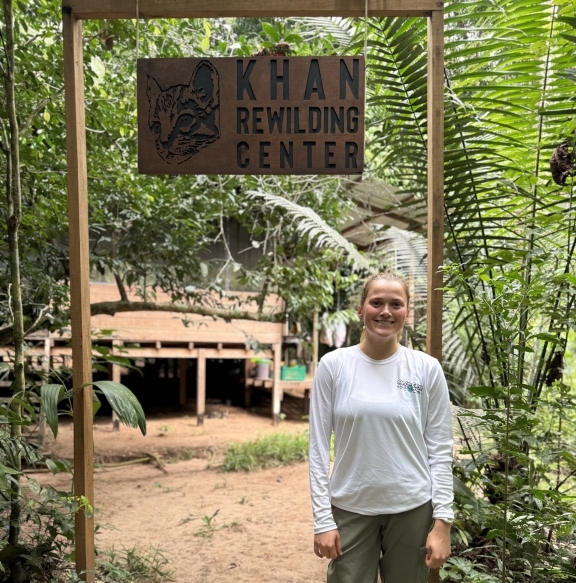
From a plane to a car to a boat to her own two feet, Marcie Bernard ’25 traveled far into the Peruvian jungle for her summer internship. The dense Amazon Rainforest envelops the Hoja Nueva conservation research center, which rehabilitates and rewilds native animals.
“Because part of the rewilding process requires total immersion of the animals in their natural habitat in the jungle, Hoja Nueva is tucked pretty deep into the Amazon,” she said. “This involves a domestic flight into Puerto Maldonado, followed by an over two-hour drive down a mud road into the Amazon to the small riverside migrant village of Puerto Lucerna, a 30-minute boat ride up the Las Piedras River and a half-mile hike inland to the center.”
Bernard’s passion for conservation was first sparked in her AP environmental studies class in high school, and when she enrolled at Washington and Lee University, she had an inkling that’s where she’d lean. Mentors such as Robert Humston, John Kyle Spencer Director for Environmental Studies and professor of biology, solidified that inclination for the biology and environmental studies – with a conservation biology focus – double major on a pre-veterinary track.
For her last summer before graduation, Bernard wanted an internship that could help her obtain animal and veterinary hours needed for vet school but in a more creative way. She wanted a distinctly unique experience compared to her previous shadowing work, in terms of the field of medicine and the species of animals. At the same time, she wanted to improve her Spanish. She stumbled upon Hoja Nueva’s website when researching wildlife rehabilitation centers in South America, and a Johnson Opportunity Grant through W&L made her dream a reality.
“The founder, Dr. Samantha Zwjicker, is also somewhat of a celebrity in the wildlife rehab/Amazon conservation world following their documentary ‘Wildcat,’ so I had been keeping up with them and their projects for a little while before deciding to apply for their internship,” Bernard said. “Hoja Nueva is really one of the first to be laying the foundation for ‘rewilding’ work – taking animals that are totally habituated and essentially teaching them how to be wild again for reintroduction – and is the only carnivore rewilding center in Peru. I knew that I would learn so much from them and get a once-in-a-lifetime experience in the outdoors through this internship.”
Founded in 2015, Hoja Nueva works to conserve and protect one of the most biodiverse places in the world. Preserving over 11.5 square miles of rainforest in the Las Piedras region, Hoja Nueva focuses on rescuing and rewilding native species, educating local communities and performing ecological research.
Animals come through the rehabilitation center in a variety of ways, such as seizure from trafficking, zoo and circus closures and illegal pet ownership. While Bernard was there, the center rescued two baby pumas from pet ownership, and she witnessed many peccaries – pig-like creatures – frequently surrendered by their owners when their naturally aggressive nature manifested as adults.
“For rewilding, they take in animals from all over Peru and have an extensive team, including a veterinarian, and individual processes for each species to take care of their health, enrich them and allow them to acclimate to their natural habitat ahead of release,” Bernard said. “Animals that show themselves to be too habituated to humans or have a disability will become sanctuary animals at the center and carry on the rest of their lives in good care there.”
Habituated doesn’t necessarily mean domesticated; it implies that the animal is affected by humans. This includes creatures that relied on humans for food or were handled as babies. In some cases, an animal is used to an urban environment and not their natural habitat. Hoja Nueva provides a place where the animals can potentially rewire their brains and behavior to be self-sufficient in the jungle.
“There isn’t necessarily a complete way to know before the animals arrive if they will be able to be ‘rewilded,’ and a lot of times they will stay in the clinic for almost a month to be watched by the vet and the rest of the team to see if they will be fit for release,” she said. “Sometimes it takes trying to rewild them and it somewhat failing to decide that they should remain a sanctuary animal. Hoja Nueva’s main objective is to release and help stabilize populations in the area, so while they will not turn away an animal with a limitation, having so many animals in the sanctuary is not a huge part of their goal as a conservation organization.”
Bernard devoted most of her time to the Khan Rewilding Center where she’d feed and enrich the non-sensitive species as well as work on enclosure maintenance.
“Enrichment typically looked like giving the animals stimulation that mimicked how they would have to gather food, climb or play in the wild,” she said. “For example, we would give the cats balls we made of vines and hide food in them so they had to work for it in a way that resembled how they would have to work for it in the wild.”
Non-sensitive species, such as amphibians and peccaries, are classified as species that can be around humans without being behaviorally affected and therefore don’t experience a setback in the de-habituation process.
“Some of my favorite activities included feeding the center’s tortoises and peccaries or doing enrichment with their sanctuary animals (non-releasable) including coatis, margays and ocelots,” she said. “On occasion, I would shadow health checks or help in picking up a variety of incoming animals like the many baby pumas we received from the nearby port village.
“My favorite moment was an ocelot pre-release health check that I got to be a part of alongside the team veterinarian as well as a pathological disease veterinarian,” she added. “Both of these vets had a lot of wisdom to share, and though I was not able to observe the release of the ocelot, this checkup and knowing what was coming for the animal was a very rewarding experience after its long journey in rehabilitation.”
Bernard also worked at the center’s partner domestic dog and cat rescue, which treats injuries, spays and neuters and rehomes animals. On the days she didn’t play with her favorite rescue dogs, Bon Bon and Scott, she helped with research projects, like going on a 10-mile hike through the jungle to set up cameras, analyzing camera data and helping with nighttime caiman surveys. And during the off-hours, the team played volleyball, swam in the river and learned how to cook Peruvian food.
“One of the coolest things about Hoja Nueva was how it pulls together such a diverse group with one thing in common – their love for conservation and animals,” she said. “I got to work with local Peruvians, Australians, South Africans, Russians, Canadians, Ph.D. candidates, high school dropouts, 19-year-olds and 75-year-olds. No matter what angle all these individuals brought to Hoja Nueva, they brought so much value, and it showed me that there is no one way to contribute to conservation and the scientific community.”
W&L classroom lessons of herpetology, ecology and Amazon land management came to life in tangible scenarios this summer for Bernard as Hoja Nueva married her majors with her future career aspirations. But it also exposed her to the various avenues that veterinary medicine could take her, such as remote veterinary medicine and conservation medicine, and the creative and holistic ways she could use her DVM. Because of her experience, she’s looking into the possibilities of more population-focused vet medicine and even dual degree programs, where she could earn her DVM and a master’s in environmental studies or public health.
“It was definitely one of the most challenging things I have ever done – traveling abroad solo not knowing anyone, throwing myself into a foreign language, demanding physical labor, sleeping under a mosquito net, limited water and internet access, camping and far removed from civilization,” she said. “But the people I met and the amount I learned about both wildlife rehabilitation and conservation in the Amazon were incredible rewarding. I would do it all over again if I could.”
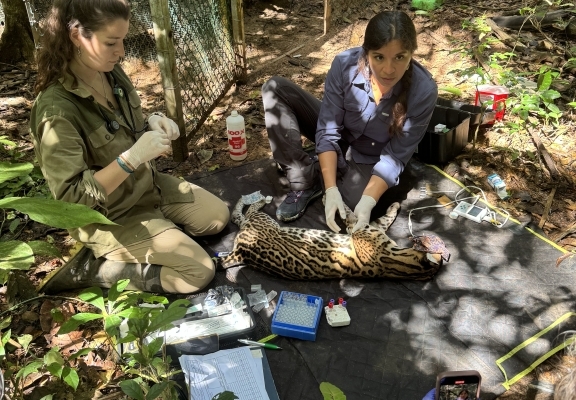 Marcie Bernard ’25 was a part of a pre-release health check of an ocelot with a team veterinarian and a pathological disease veterinarian.
Marcie Bernard ’25 was a part of a pre-release health check of an ocelot with a team veterinarian and a pathological disease veterinarian.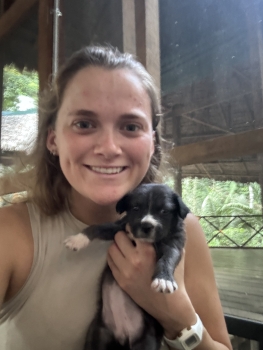 Marcie Bernard ’25 also worked at Hoja Nueva’s domestic dog and cat rescue.
Marcie Bernard ’25 also worked at Hoja Nueva’s domestic dog and cat rescue.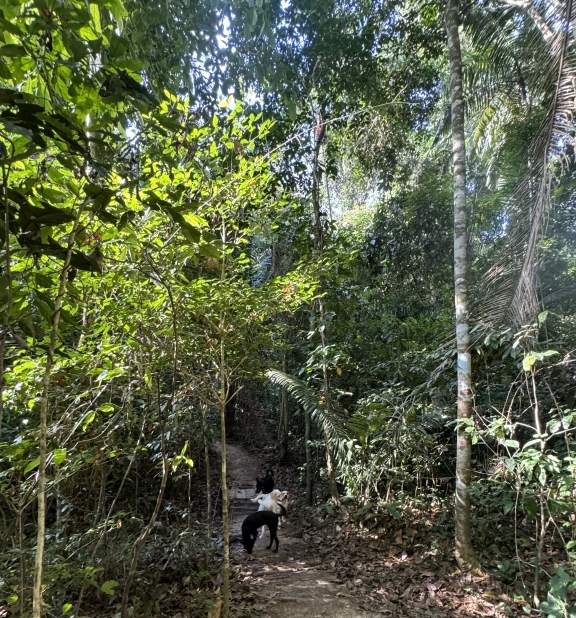 Marcie Bernard ’25 worked with rehoming rescue dogs in the Amazon Rainforest.
Marcie Bernard ’25 worked with rehoming rescue dogs in the Amazon Rainforest.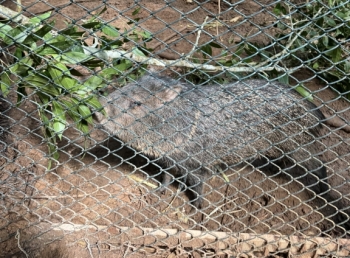 Peccaries are considered non-sensitive species, and Marcie Bernard ’25 helped the ones at Hoja Nueva prepare to return to the wild.
Peccaries are considered non-sensitive species, and Marcie Bernard ’25 helped the ones at Hoja Nueva prepare to return to the wild.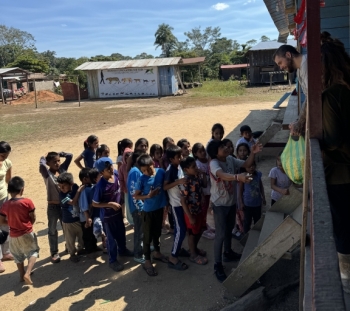 Her internship at Hoja Nueva also included outreach at local schools in Peru.
Her internship at Hoja Nueva also included outreach at local schools in Peru.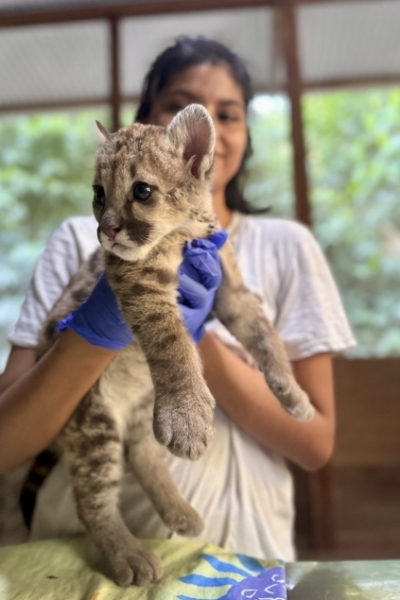 A baby puma was rescued by Hoja Nueva.
A baby puma was rescued by Hoja Nueva.
You must be logged in to post a comment.